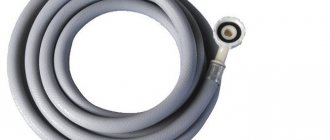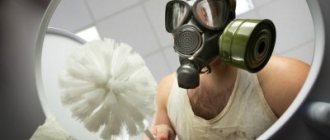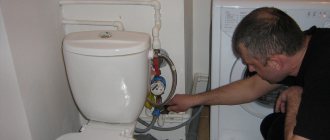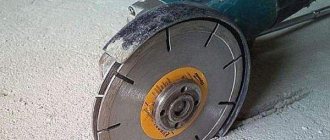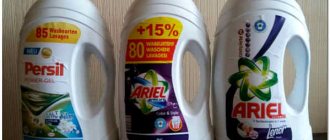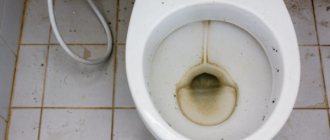We traditionally expect clean laundry from a washing machine, fragrant with freshness... We choose aromatic powders and rinse aids that are pleasant to our sense of smell... but sometimes it all turns out to be in vain: the washing machine suddenly begins to emit an unpleasant odor.
Sometimes it can only be felt from the unit itself, but in particularly advanced cases, freshly washed items also begin to smell musty. What happened to your faithful assistant and what to do now? Unfortunately, if the smell has spread to the laundry, you will have to work on it manually: rinse it in a bathtub with air conditioning. But to deal with the machine that put you in such an unpleasant situation. There can be many reasons for a bad smell in a washing machine.
Why and how does odor occur in the washing machine?
Many people are interested in how to clean an automatic washing machine from smells? Why does the washing machine start to smell rotten and rotten if we do everything the same, use the same powder and don’t change anything? How to get rid of an unpleasant odor? It is important to understand the reasons. It turns out that when caring for the washing machine, we often make traditional mistakes that lead to the appearance of an unpleasant odor. The causes of unpleasant odor from an automatic washing machine are staphylococci, molds and E. coli. A rotten smell appears when entire colonies of bacteria form in the unit. In order for them to reproduce, they require moisture and warmth. The washing machine is the ideal place for this. Housewives do a lot of things wrong:
- Close the door. If you leave the loading hatch closed after finishing the wash, bacteria will begin to form inside, as an ideal environment will be created for their development.
- We strive to save energy. When we wash at low temperatures, microorganisms are not destroyed. Requires heating to 90 degrees. Favorite washing modes at 30 or 40 degrees become favorable for the development of entire colonies.
- We use low quality powder. The same can be said about the rinse aid. If the product is bad, it does not dissolve completely in water. Particles remain on the filters, drum and other parts of the machine. Such plaque is an ideal environment for the development of bacteria.
- We do not follow the dosages indicated on the packages. Manufacturers specifically prescribe the required amounts of detergents. Using more quantity does not guarantee quality. Excess remains on all elements, powder tray, filters, hoses and other parts of the unit. They are also not rinsed completely, so the laundry turns an unsightly gray color.
- We don't check the pockets. Leftover food, crumbs, candy and pieces of paper, as well as other debris, become soaked and settle on the hoses and filters.
- Wash with too hard water. The water contains salts and particles of organic origin, which are deposited on the heating element. Gradually, the carbon begins to break off and form a sediment. This becomes a favorable environment for the development of entire colonies of harmful microorganisms.
- We install the washing machine unevenly. If the device is tilted, the water does not drain completely into the sewer. Partially it remains and begins to rot.
- We do not regularly clean the filter. During the draining process, hair and large debris remain on the filter. They then decompose and lead to a foul odor.
- We do not rinse the bath, which is intended for detergents. A slimy coating appears, which favors the development of mold and other abominations.
- After completing the wash, do not wipe the drum. There is water left in it. Gradually it begins to fade and stink.
- Do not wash the rubber cuff that is provided on the loading hatch. This is how a lot of garbage accumulates.
- We store dirty laundry in the drum. Bacteria begin to multiply and produce an unpleasant odor.
- We do not trust installation to experienced specialists. It is likely that the drain hose is not connected correctly to the sewer. The drain hole should be located at a maximum height of 50 cm from the floor. The hose is fastened in the shape of the letter U. Otherwise, an unpleasant odor will appear.
Removing the smell from the washing machine will be a priority task that will have to be resolved quickly. If you find out the reason, you can quickly eliminate this problem.
Tips for Extending Lifespan
To eliminate problems and extend the life of household appliances, experts recommend following five rules.
- Storing clothes in a basket. Dirty laundry should be placed not in the drum, but in special baskets. Moreover, the storage container must allow air to pass through, otherwise bacteria will begin to accumulate on the wet, soiled fabric.
- Alternating temperature conditions. Fans of “quick washing” should alternate short cycles with long ones, once a week change the temperature from 40 to 60-80°C, and at least sometimes wash on a full cycle at 90°C.
- Use suitable powder. It is recommended to use powders intended only for vending machines, observing the exact dosage. You can use liquid products, which, as a rule, are washed away without leaving a residue.
- Washing filters. Filters should be cleaned periodically. The inlet filter is located inside the water supply opening and should only be removed after turning off the taps. The drain filter is located at the bottom, on one of the walls of the machine. Before unscrewing it, you need to place a rag or a low basin - a lot of water usually pours out of the hole.
- Using descaling products. You should soften the water and periodically use cleaners for heating elements. Expensive powders already contain agents that protect heating elements and parts, so additional cleaning is required no more than once a week.
The owners of the car are not always at fault. Often, unskilled technicians incorrectly connect equipment to the drain, and some of the waste water remains inside the hoses. This can happen when the machine is installed at an angle. If the hose is kinked or connected too high, then the center of the stench is most likely located here. In addition, the smell can come from the drain if there is a clog in the drain. “Aromatic” amber is emitted by the sink, bathroom, and other plumbing fixtures in the house.
Special products for getting rid of odors in the machine
If there is a sewer smell coming from your washing machine, you can use special preparations to effectively eliminate the nasty aroma. Most often we trust advertising in choosing this or that product, but here we should be very careful. Here are our recommendations:
- Calgon is a highly advertised product, but it is absolutely not effective.
- Antiscale is a good, proven product available from many manufacturers. Among the minuses, it is worth noting the possible clogging of the drain hose from cleared scale.
- Special cleaners, such as Dr. Beckmann - very good, according to reviews, for getting rid of scale and dirt.
Before using the drugs, it is important to carefully study the attached instructions. Do not use multiple cleaners at the same time. Work must be performed wearing a respirator and gloves.
Dishwasher tablets
Another good way is dishwasher tablets. Cleaning your washing machine from smells will be a real pleasure. Today, products have been developed that easily remove plaque and grease from dishes, help disinfect and eliminate unpleasant odors. They can easily cope with identical problems in the washing machine. You need to take five tablets and put them in the drum. After this, the wash starts at high temperature. Next, do the rinsing. It is important to thoroughly wipe all accessible parts dry. This method is suitable when the pollution is not so strong. You can also carry out monthly prevention with home remedies.
Vinegar
If you don’t know how to remove the smell from your washing machine, know that you can use home remedies if you wish. Regular vinegar is especially often used, which effectively eliminates unpleasant odors. Now it's so easy to clean your washing machine from musty smells. It will be possible to dissolve lime deposits on the heating elements. In combination with hot water, the composition can easily cope with mold and bacteria. Cleaning with vinegar is allowed once every six months. Acid can damage machine parts made of rubber.
Eliminating odor in an automatic washing machine begins by taking a glass of acid and pouring it into the powder tray. After this, the mode is set in which the laundry is usually boiled. The temperature should be 90 degrees. When the main wash stage is completed, you need to pause. The unit is left in this state for a couple of hours. Then the machine is started again in rinse mode. You must wait until the program completes. It is necessary to unscrew the pump filter to drain. There may remain pieces of soot that have broken off. Finally, an additional rinse is started. Vinegar is also used instead of rinse aid. Three tablespoons of acetic acid are poured into the compartment intended for rinsing. This will prevent the smell of rot. If you use apple cider vinegar, your laundry will have a pleasant aroma.
Stages of cleaning activities
Let's try to disassemble the machine and check all accessible parts of the mechanism for the presence of various unpleasant microorganisms on them.
Stage #1 - disassemble the washing machine
To do this, you need to disconnect it from the power supply, water supply and drainage, and provide access to the equipment from all sides.
After disconnecting the washing machine from power, wait 15-20 minutes for all appliances to turn off. It is advisable to move the machine and check the space under it: dirt on the floor or stand can also be a source of an unpleasant odor.
Let's prepare the necessary tools:
- round nose pliers, pliers or pliers;
- Phillips and slotted screwdriver;
- hammer;
- keys - open-end, heads;
- marker;
- an old toothbrush;
- brush (preferably Kevlar);
- flashlight.
First, remove the top, bottom and side covers of the washer. Look at the design: unscrew the panels secured with self-tapping screws, and pull the rest towards you.
The control unit, wires, drum, engine do not need to be touched. If there is dirt on them, carefully remove them. Look inside the machine, shine a flashlight through every detail, remove debris and dust where possible.
More details about how to disassemble a washing machine are written in this material.
Study the main components of the washing machine before disassembling, look at the instructions: it describes the design features of your particular model
Take pictures or film your actions, this will make it easier to put the parts in place later. Now let's look at the individual elements where colonies of microorganisms prefer to live.
Stage #2 - clean or change the cuff
The rubber seal is constantly in contact with moisture and is not able to self-clean due to its shape. Stagnation of liquid in it leads to the formation of rot.
Black spots can be removed with any chlorine-containing solution diluted with water - regular “Belizna” or “Domestos”, “Toilet duck”.
The algorithm of actions is as follows:
- Wear rubber gloves.
- Wash the cuff of the loading hatch with a chlorine-containing solution.
- Close the machine.
- After 30-40 minutes. you need to turn on the rinse mode. But our machine is disassembled and turned off, we’ll do it later.
If it is impossible to wash the cuff or it has become unusable, it can be removed and replaced with a new one. The rubber seal is attached to the tank body with two clamps.
First you need to bend the front edge and remove the first plastic clamp from the latch. If the clamp is metal, it is moved away with a screwdriver.
There is a spring on the metal clamp, you need to pull it towards you and loosen it, unscrew the screw (if there is one), then the ring can be easily removed
Next, carefully pull out the first part of the cuff and make a mark with a marker so that you can easily insert a new elastic band later. It will then need to be combined with the mark on the tank itself.
We similarly release the other part of the cuff from the second clamp and tuck the elastic band inside the drum.
To completely remove the cuff, you need to unscrew the bolts from the back, remove the housing cover, pull out the powder container, unscrew the bolts underneath, release the latches of the control panel, remove it, remove the bottom panel, unscrew the facade and provide access to the sealing rubber
Try washing the removed rubber seal, maybe it will still serve. If nothing can save her, take the old cuff and buy a new one of the same size.
Before installing a new cuff, you need to wash the edge of the tank with warm soapy water. Do not wash the soap film, it will serve as a lubricant. To put the elastic in place, place the top of the elastic against the edge of the tank along the marks and use your thumbs to tighten the elastic.
The triangular marks on the drum and the cuff of the loading hatch must match: if the sealing rubber moves even a couple of millimeters, there will be leaks
Slide from the center around the circle. When the cuff is in place, check the fit and secure it with clamps.
Stage #3 - clean the detergent loading compartment
Removing the part is quite simple with a top-loading machine - unscrew the plastic screws and remove the tray. In some horizontal-loading washing machines, it is more difficult to pull out. Do not rush to tug and tear out the container.
Look in the instructions for the machine - there are models where it can be removed with one click on the tab near the rinse aid compartment. If the container comes out like a fan, you need to open it all the way, then lift it, pull it towards you and pull it out.
Consider the detergent tray, there probably is a special valve there - modern manufacturers make this design simple and easily removable
How to remove the straight horizontal detergent tray:
- Pull it all the way.
- Examine the bottom of the container.
- If cloves are visible on both sides deep down, grease them with any vegetable oil.
- Lift the container up and pull it towards you, it will move 1-2 millimeters.
- Press the top of the tray until it clicks and pull, it should come out freely.
After removal, the tray must be cleaned of plaque and mold. Use suitable household chemicals for this. You can fill the tray with soda, vinegar, or vinegar-soda hot solution.
Exposure time - 6-8 hours. After this, the dirt will fall away and be easily removed. Citric acid will also work. Wipe the clean tray dry and place it back in the washing machine compartment.
Stage #4 - cleaning the drainage system
The system can be cleaned without disassembling using special products that remove deposits. Powders, solutions, tablets are used according to the instructions on the package.
Regular soda will also work. 150 g of powder should be poured into the drum and rotated without laundry on the longest setting. But our machine has been disassembled, so we’ll clean everything completely.
To get to the drainage system:
- Cover the floor with a soft cloth and turn the washer on its side.
- Place plenty of rags under the drainage system to prevent any remaining water from damaging the flooring.
- Using a flathead screwdriver, remove the bottom panel.
- Unscrew the bolts that hold the filter.
- Remove the filter.
- Use pliers to loosen the clamp and separate the hose from the pump and housing.
The hose in top-loading machines is located on the side. To remove it, we release the fasteners, remove the panel, unscrew the clamp, and pull out the hose.
When it is already in your hands, we begin to clean it, inserting a brush from one side or the other. We rinse the hose under running hot water and return it to its place.
If the drain hose has become unusable, it is easy to replace it: measure the required length, buy a part (it is better to take a regular one, not a telescopic one) and put it in place of the old one
Now let's move on to the filter . We clean it of all contaminants and rinse it with water. If there is plaque, soak the filter in a citric acid solution for several hours, after which we remove the deposits.
We highlight the place where the filter is installed with a flashlight and also clean it of debris. We return the part to its place.
Don't forget about the filter for a long time. It is easily accessible from the outside of the machine by simply turning the plug itself counterclockwise.
If the filter is secured with a bolt, it is easy to unscrew it without disassembling the machine. The part needs to be cleaned every 2-3 months or six months, depending on the frequency of washing.
An overview of the best ways to clean the filter in washing machines can be read here.
Another participant in the drainage system is the pump . Disconnect the wires leading to it and unscrew the device. The most problematic part is the impeller. It is easy to get out by unscrewing the screws that connect the body.
As the washer operates, the impeller rotates, so it wraps around debris. We remove dirt from it, wipe the inside of the pump, clean the hoses and put everything back together.
Stage #5 - clean the water supply channel
Removing the fill tube will reveal the inlet filter. We carefully remove this fine mesh with pliers. Remove it with extreme care; it is very fragile. Happened? Now clean the filter with a toothbrush and rinse with water.
Manufacturers recommend cleaning filters every six months and not forgetting about the nest - a flashlight will help to carefully inspect all areas
Clean and rinse the filler tube. Often debris collects on its walls and a silty coating appears. Clean with a brush and rinse with hot running water. We connect all the parts together and install them back.
Stage #6 - clean or change the heating element
Scale on the coil (TENE) is another source of bad odor. This is not quite a traditional coating, like on the walls of a teapot. It is formed not so much from the quality of the water as from debris and detergent residues.
If you rarely use the machine and turn it on at minimum temperature, the plaque begins to rot, emitting a characteristic “aroma” in the process. But high washing temperatures do not help - a burning smell appears.
There are two ways to remove scale: physical and chemical. Physical involves removing plaque manually with hard objects.
It is not recommended to do this yourself; there is a risk of damaging the spiral. Let's make do with a chemical one, use a solution of citric acid. But more on that later.
Let's see what condition the heating element is in. Remember, at the very beginning, when washing at maximum temperature, you had to check whether the water was warm enough? Maybe the machine washes without heating and this is the reason for the unpleasant smell?
Then you need to replace the heating element. In most models it is located at the back, so it is not difficult to find.
How to understand that the heating element requires replacement: visually there is a lot of scale on it, which citric acid can no longer cope with, plus you can measure the resistance with a multimeter - the working device will show 24 Ohms
Let us consider in detail the process of replacing the heating element:
- Remove the wires from the heating element.
- We turn the fixing nut in the middle of the heating element (let it remain on the edge of the thread, do not remove it).
- We press the nut inward, you can tap it with a hammer.
- We take out the heating element. If it doesn’t work, pry it off with a slotted screwdriver or a knife.
- We put the old part aside and install the new one, repeating the algorithm in reverse order.
If you still don’t need to replace the heating element, the amount of scale is not critical, return all the parts to their place, close the machine, tighten all the bolts, connect it to water and electricity.
Pour 150-200 g of citric acid into the powder container, set the longest mode at maximum temperature and run the washing machine without laundry.
If you have cleaned all the places where microorganisms could develop their vital activity, replaced parts that have become unusable, but the unpleasant odor remains, the problem is hidden in the general building communications.
This is evidenced by the smell of rot from the shells. Contact your service company. It’s good if the unpleasant smell has disappeared, but how to prevent such a situation in the future?
Lemon acid
Citric acid will help remove odors from your washing machine. Cleaning your car with citric acid is allowed every four months. 100 g of acid must be poured into the powder tray. After this, select a program that guarantees maximum water heating. After this, an additional rinse is required. Finally, the cuff and drum should be thoroughly wiped. We leave the door open. If washing is performed frequently, it is possible to carry out this procedure for prevention every month or two. But in this case you need to take a maximum of two tablespoons of acid.
Baking soda
Another option to remove unpleasant odors from your washing machine is baking soda. This will get rid of mold inside the unit. You will also be able to forget about fungal plaque. You don't have to think about why your washing machine smells bad. You just need to take a glass of water and a glass of soda. The solution is applied to all affected parts. Another glass of sodium bicarbonate is poured instead of powder. After this, boiling is started, as well as additional rinsing. Copper sulfate can be a substitute for meat. To do this, take a liter of water and dilute 30 g of vitriol in it. Available parts are processed, and the remainder is poured into the drum. After this, the wash is started, at which the water heats up to 90 degrees.
Sources
Most often the smell is caused by:
- scale on internal parts;
- bacteria;
- fungi (mold);
- garbage.
The immediate cause is microorganisms, and scale, debris and lack of necessary ventilation serve as a favorable environment for their proliferation.
Washer smell
First you need to determine which part of the machine the source is in. It could be:
- tray for washing powder;
- a pipe connecting the container and the tank;
- a rubber sealing ring that serves to seal the hatch and prevent leakage;
- inlet hose through which water is supplied to the machine;
- drain hose;
- washing compartment (hatch), especially the bottom;
- drain filter;
- tubular electric heater (TEH).
Expert opinion
I work in the household appliance repair industry. Extensive experience in restoring washing machines and dishwashers.
Ask a Question
The sealing lip is a common place for bacteria to live. It doesn't dry well, and pieces of fabric, threads from clothes, and small debris constantly get there. All this accumulates, becomes damp, rots and stinks.
Chlorine-containing products
Chlorine will help remove odors from your washing machine. Using chlorine-containing compounds is very convenient to get rid of unpleasant odors. At the same time, they additionally disinfect. You can take any chlorine-based product. An example is whiteness. You should take 100 g and pour it into the compartment intended for powder. After this, the boiling program starts. An additional rinse is required. The drum and cuff are wiped after use so that the chlorine does not “eat” the rubber. The door is not closed. It is necessary to ventilate the room well after cleaning. You can also wash your washing machine to remove the rotten smell.
Bacterial breeding sites
Bacteria often affect the following parts of the washing machine:
- powder container;
- rubber gasket inside the drum;
- heating elements - heating elements;
- drum bottom;
- hose for draining water into the sewer;
- rubber ring around the door;
- a hose that leads from the powder tray to the tank;
- channel through which detergents pass.
How to prevent odor in your washing machine
Many people worry that if their washing machine smells rotten, what should they do? It is worth trying to avoid problems rather than solve them. If you don’t want to constantly think about why your washing machine smells like rotten water, you should follow these simple recommendations:
- To avoid smell from the washing machine during washing, do not leave laundry in the unit: washed or dirty.
- The unit must be thoroughly ventilated after each wash. Otherwise, there will be a damp smell in the washing machine.
- Preventive measures should be carried out regularly to eliminate scale and fungus. For example, you can wash your washing machine to remove odors.
- If you need to wash things that are stained with gasoline and other caustic substances, you should first rinse the clothes and only then wash them. Otherwise, you will have to wonder why your washing machine smells rotten. It is important to purchase high-quality powders and gels. You should not buy goods of dubious quality.
- It is good to wash things at high temperatures. With regular cold washing, mildew will inevitably appear and a musty smell will appear in the washing machine.
- If problems are noticed in the operation of the unit, you should immediately contact professionals with solid experience. The technician will be able to find out why the smell appeared from the washing machine drum. He will quickly solve this problem.
Now you know how to get rid of the smell in your washing machine. If you follow certain rules and regularly clean your machine, you can significantly extend its service life. If there is an unpleasant odor in your washing machine, act quickly. Write about what tools helped you in the comments!


